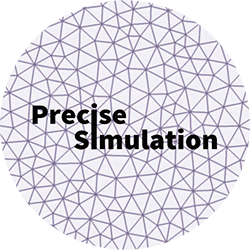
|
FEATool Multiphysics
v1.17.5
Finite Element Analysis Toolbox
|

|
FEATool Multiphysics
v1.17.5
Finite Element Analysis Toolbox
|
EX_NAVIERSTOKES4 2D Example for incompressible flow over a backwards facing step.
[ FEA, OUT ] = EX_NAVIERSTOKES4( VARARGIN ) Stationary flow over a backwards
[1] P.M. Gresho and R.L. Sani, Incompressible Flow and the Finite Element Method, Volume 1 & 2, John Wiley & Sons, New York, 2000.
[2] A. Rose and B. Simpson: “Laminar, Constant-Temperature Flow Over a Backward Facing Step,” 1st NAFEMS Workbook of CFD Examples, Glasgow, UK, 2000.
Accepts the following property/value pairs.
Input Value/{Default} Description
-----------------------------------------------------------------------------------
re scalar {389} Reynolds number
h scalar {1} Channel height
y scalar {0.485} Step height (fraction of channel height)
lc scalar {7.92} Channel length (fraction of channel height)
li scalar {1.98} Inlet length (fraction of channel height)
hmax scalar {0.1} Max grid cell size
sf_u string {sflag1} Shape function for velocity
sf_p string {sflag1} Shape function for pressure
iphys scalar 0/{1} Use physics mode to define problem (=1)
solver string openfoam/su2/{} Use OpenFOAM, SU2 or default solver
iplot scalar 0/{1} Plot solution (=1)
.
Output Value/(Size) Description
-----------------------------------------------------------------------------------
fea struct Problem definition struct
out struct Output struct
cOptDef = { ...
're', 389;
'h', 1;
'y', 0.0049/0.0101;
'lc', 0.08/0.0101;
'li', 0.02/0.0101;
'hmax', 0.1;
'sf_u', 'sflag1';
'sf_p', 'sflag1';
'iphys', 1;
'solver', '';
'iplot', 1;
'tol', 0.2;
'fid', 1 };
[got,opt] = parseopt(cOptDef,varargin{:});
fid = opt.fid;
% Geometry and grid parameters.
h = opt.h; % Height of channel.
y = opt.y; % Height of step.
lc = opt.lc; % Length of channel.
li = opt.li; % Length of inlet.
% Model parameters.
umax = 1; % Maximum magnitude of inlet velocity.
rho = 1; % Density.
miu = umax*2/3*h/opt.re; % Molecular/dynamic viscosity.
% Discretization parameters.
sf_u = opt.sf_u; % FEM shape function type for velocity.
sf_p = opt.sf_p; % FEM shape function type for pressure.
% Geometry definition.
vert = [ -li*h lc*h lc*h 0 0 -li*h; ...
(1-y)*h (1-y)*h -y*h -y*h 0 0];
gobj = gobj_polygon( vert' );
fea.geom.objects = { gobj };
fea.sdim = { 'x' 'y' }; % Coordinate names.
% Grid generation.
fea.grid = gridgen(fea,'hmax',opt.hmax,'fid',fid);
n_bdr = max(fea.grid.b(3,:)); % Number of boundaries.
% Boundary conditions.
dtol = opt.hmax;
i_inflow = findbdr( fea, ['x<',num2str(-li*h+dtol)] ); % Inflow boundary number.
i_outflow = findbdr( fea, ['x>',num2str( lc*h-dtol)] ); % Outflow boundary number.
s_inflow = ['4*',num2str(umax),'*(y*(',num2str((1-y)*h),'-y))/',num2str((1-y)*h),'^2']; % Definition of inflow profile.
u_init = ['4*',num2str(umax),'*(y*(',num2str((1-y)*h),'-y))/',num2str((1-y)*h),'^2*(y>0)'];
% Problem definition.
if ( opt.iphys==1 )
fea = addphys(fea,@navierstokes); % Add Navier-Stokes equations physics mode.
fea.phys.ns.eqn.coef{1,end} = { rho };
fea.phys.ns.eqn.coef{2,end} = { miu };
if( ~strcmp(opt.solver,'openfoam') )
fea.phys.ns.eqn.coef{5,end} = { u_init };
end
fea.phys.ns.sfun = { sf_u sf_u sf_p }; % Set shape functions.
fea.phys.ns.bdr.sel(i_inflow) = 2;
fea.phys.ns.bdr.sel(i_outflow) = 4;
fea.phys.ns.bdr.coef{2,end}{1,i_inflow} = s_inflow; % Set inflow profile.
fea = parsephys(fea); % Check and parse physics modes.
else
fea.dvar = { 'u' 'v' 'p' }; % Dependent variable name.
fea.sfun = { sf_u sf_u sf_p }; % Shape function.
% Define equation system.
cvelx = [num2str(rho),'*',fea.dvar{1}]; % Convection velocity in x-direction.
cvely = [num2str(rho),'*',fea.dvar{2}]; % Convection velocity in y-direction.
fea.eqn.a.form = { [2 3 2 3;2 3 1 1] [2;3] [1;2];
[3;2] [2 3 2 3;2 3 1 1] [1;3];
[2;1] [3;1] [] };
fea.eqn.a.coef = { {2*miu miu cvelx cvely} miu -1;
miu {miu 2*miu cvelx cvely} -1;
1 1 [] };
fea.eqn.f.form = { 1 1 1 };
fea.eqn.f.coef = { 0 0 0 };
% Define boundary conditions.
fea.bdr.d = cell(3,n_bdr);
[fea.bdr.d{1:2,:}] = deal(0);
fea.bdr.d{1,i_inflow} = s_inflow;
[fea.bdr.d{:,i_outflow }] = deal([]);
% fea.bdr.d{end,i_outflow} = 0; % Set pressure to zero on outflow boundary.
fea.bdr.n = cell(3,n_bdr);
end
% Parse and solve problem.
fea = parseprob(fea); % Check and parse problem struct.
if( opt.iphys==1 && strcmp(opt.solver,'openfoam') )
logfid = fid; if( ~got.fid ), fid = []; end
fea.sol.u = openfoam( fea, 'nproc', 1, 'fid', fid, 'logfid', logfid );
fid = logfid;
elseif( opt.iphys==1 && strcmp(opt.solver,'su2') )
logfid = fid; if( ~got.fid ), fid = []; end
fea.sol.u = su2( fea, 'init', {s_inflow,0,0}, 'fid', fid, 'logfid', logfid );
fid = logfid;
elseif( opt.iphys==1 && strcmp(opt.solver,'fenics') )
fea = fenics( fea, 'fid', fid, 'nproc', 1 );
else
fea.sol.u = solvestat(fea,'fid',fid,'maxnit',50,'nlrlx',1,'tolchg',1e-3); % Call to stationary solver.
end
% Postprocessing.
s_velm = 'sqrt(u^2+v^2)';
if ( opt.iplot>0 )
figure
subplot(3,1,1)
postplot(fea,'surfexpr',s_velm,'evaltype','exact','isoexpr',s_velm)
title('Velocity field')
subplot(3,1,2)
postplot(fea,'surfexpr','p','evaltype','exact')
title('Pressure')
subplot(3,1,3)
h = postplot(fea,'surfexpr',['(u<-eps)*x/',num2str(y)]);
title('Separation length')
end
% Error checking.
s_expr = ['(u<-eps)*x/',num2str(y)];
[~,slen] = minmaxsubd( s_expr, fea );
if( ~isempty(fid) )
fprintf(fid,'\nRecirculation zone length: %3f (Ref: 7.93)\n\n',slen)
fprintf(fid,'\n\n')
end
out.slen = [slen, 7.93];
out.err = abs(diff(out.slen))/out.slen(end);
out.pass = out.err<opt.tol;
if ( nargout==0 )
clear fea out
end